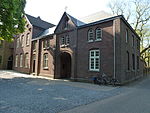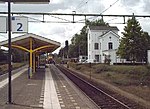Lilbosch Abbey
1883 establishments in the Netherlands19th-century architecture in the NetherlandsChristian monasteries in Limburg (Netherlands)Echt-SusterenTrappist monasteries in the Netherlands

Lilbosch Abbey (Dutch: Abdij Lilbosch) is a monastery of the Trappists (Cistercians of the Strict Observance) founded in 1883 and located in Lilboscherveld in Pepinusbrug, Echt, Limburg, in the Netherlands.The abbey is largely self-sufficient thanks to its own farm, which has an area of 110 hectares and supports not only the cultivation of crops but also free-range pig-keeping, calf-rearing and bee-keeping. The farming techniques are organic, as far as possible. Apart from the farmland the abbey has another 30 hectares or so of natural uncultivated land.
Excerpt from the Wikipedia article Lilbosch Abbey (License: CC BY-SA 3.0, Authors, Images).Lilbosch Abbey
Pepinusbrug, Echt-Susteren
Geographical coordinates (GPS) Address External links Nearby Places Show on map
Geographical coordinates (GPS)
| Latitude | Longitude |
|---|---|
| N 51.083333333333 ° | E 5.9147222222222 ° |
Address
Abdij Lilbosch
Pepinusbrug
6102 RJ Echt-Susteren
Limburg, Netherlands
Open on Google Maps











